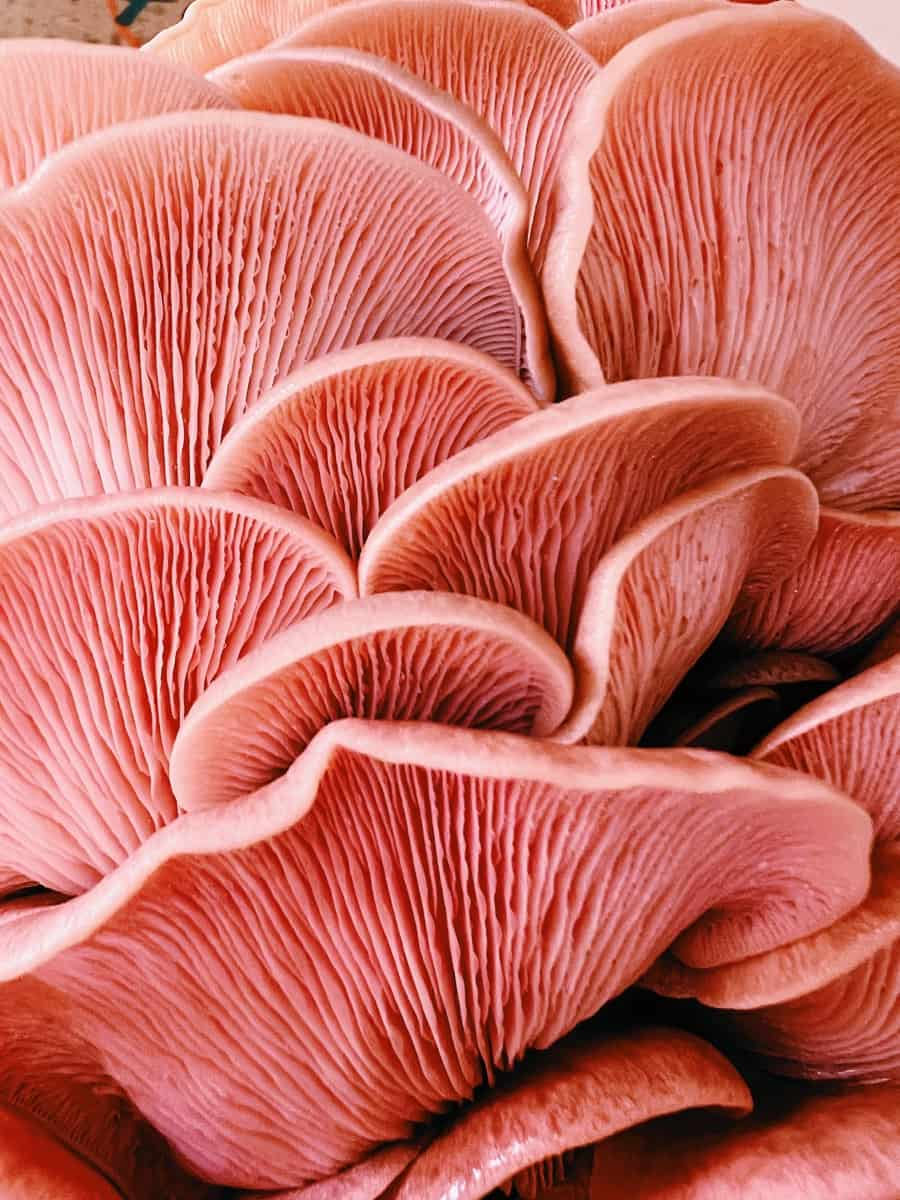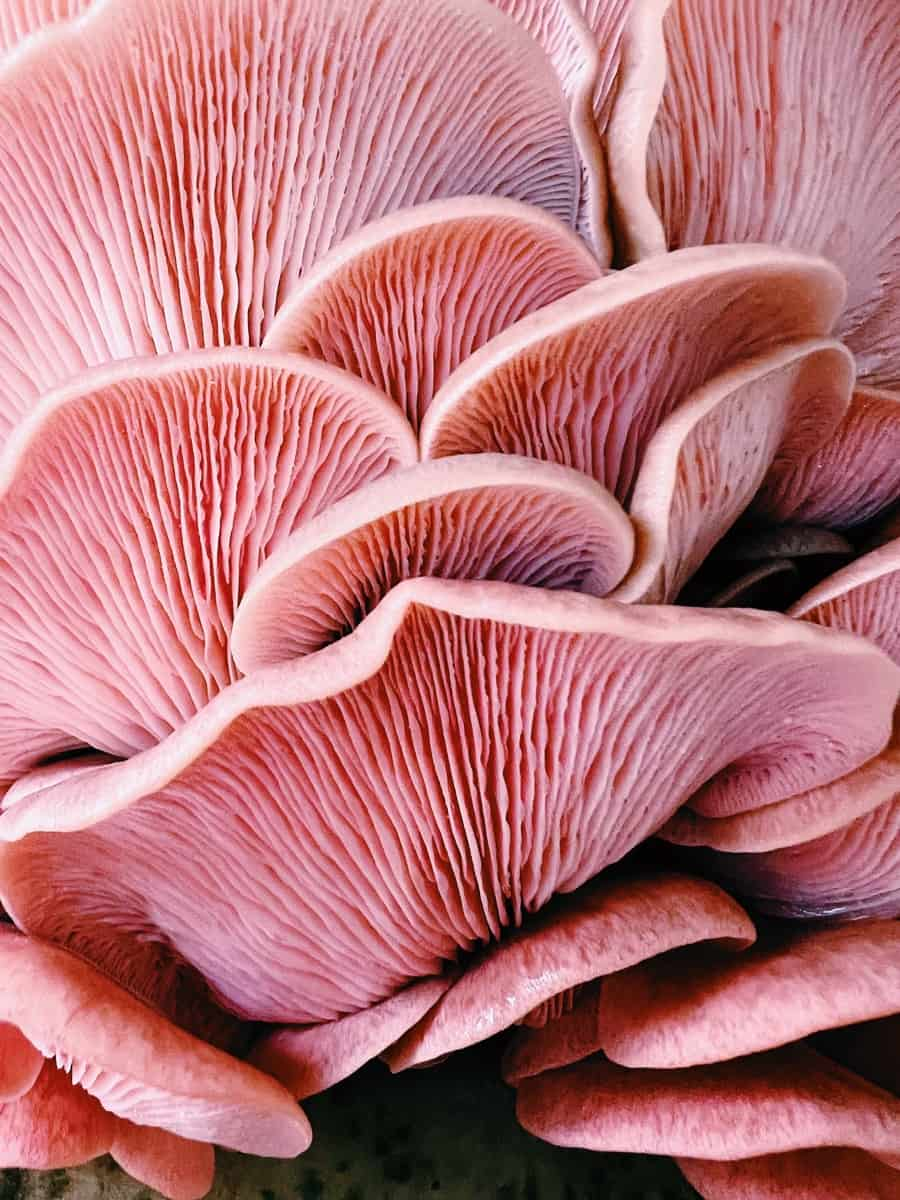The Pink Oyster Mushroom, scientifically known as Pleurotus djamor, is a vibrant and aesthetically pleasing mushroom species. It is characterized by its striking pink coloration, which can vary from light pink to deep magenta. Pink Oyster Mushrooms are commonly cultivated for their culinary uses due to their delicate and mild flavor profile.

They are also known for their potential health benefits, as they are a good protein source, vitamins, and minerals. In this guide, we will walk you through the step-by-step process of growing pink oyster mushrooms, from selecting the right growing medium to harvesting the bountiful fruits of your labor.
Pink Oyster Mushroom Growth Stages: Pink Oyster Mushroom Life Cycle
The life cycle begins with spore germination. When pink oyster mushroom growing conditions are favorable, spores land on a suitable substrate and develop into mycelium, which is the vegetative part of the fungus. The mycelium then colonizes the substrate, breaking it down and preparing for fruiting. Next comes the pinning stage, where small, pin-like structures emerge from the pink oyster mushroom mycelium.
These pins gradually develop into fruiting bodies, which are the actual mushrooms. The pink oyster mushrooms have vibrant pink to salmon-colored caps and white stems. During the fruiting stage, the mushrooms rapidly grow in size and maturity, reaching their peak when the caps flatten out. At this point, the mushrooms are ready for harvest and consumption. Proper harvesting techniques ensure maximum yield and quality.
Creating the Ideal Growing Environment for Pink Oyster Mushrooms
Creating the ideal growing environment for pink oyster mushrooms is crucial for their successful cultivation. These delicate fungi thrive best in a controlled environment with specific conditions. Firstly, ensure a temperature range of 18-24°C to support optimal growth. Secondly, maintain a pink oyster mushroom growing humidity level of 80-90% to ensure adequate moisture for the mushrooms.
Additionally, provide indirect light for 12-16 hours daily, as excessive light can hinder growth. The pink oyster mushrooms also require proper air circulation, so ensure adequate ventilation. Finally, use a substrate such as straw or sawdust to provide a nutritious base for the mushrooms to grow.
Selecting the Right Substrate for Pink Oyster Mushroom Cultivation
Selecting the right substrate is crucial for successful pink oyster mushroom cultivation. The substrate serves as the growing medium and provides essential mushroom nutrients. Several options are suitable for pink oyster mushrooms, including wheat straw, sawdust, and coffee grounds. Wheat straw is commonly used due to its availability and favorable nutrient composition.
Sawdust, particularly hardwood sawdust, is another popular choice. Coffee grounds, a waste product, can also be utilized. Ensuring the substrate is properly prepared by sterilization or pasteurization is important to eliminate competing organisms. Maintaining the right moisture levels and temperature throughout the cultivation process is essential for optimal growth.
Preparing the Substrate for Pink Oyster Mushroom Growth
To ensure successful growth of Pink Oyster Mushrooms, it is crucial to prepare the substrate properly. Start by selecting a suitable substrate, such as straw or sawdust. Next, sterilize the substrate to eliminate competing organisms hindering mushroom growth. This can be done through pasteurization or autoclaving.
After sterilization, allow the substrate to cool down before adding the Pink Oyster Mushroom spawn. Mix the spawn thoroughly into the substrate, ensuring even distribution. Finally, transfer the substrate and spawn mixture into a suitable growing container and provide the ideal conditions for growth, including temperature, humidity, and lighting.
Spawning and Inoculating Pink Oyster Mushroom Spawn
Spawning and inoculating Pink Oyster Mushroom spawn is essential to successful cultivation. Begin by obtaining high-quality spawn from a reliable source. Ensure that the spawn is fresh and free from contamination. Choose a suitable substrate, such as straw or sawdust, and sterilize it to create a clean environment for the spawn.
Once the substrate has cooled down, transfer it to a sterile container and evenly distribute the spawn throughout the substrate. Mix thoroughly to ensure proper inoculation. Maintain consistent temperature and humidity conditions for the spawn to colonize the substrate effectively. Regularly monitor and provide necessary care until the mushrooms start to grow.
In case you missed it: Benefits of Mushroom Compost in Gardening: How to Make at Home and Use for Plants

How Long is Pink Oyster Incubation?
The incubation period for pink oyster mushrooms typically lasts 10 to 14 days. The mycelium colonizes the substrate during this time, forming a network of white filaments. As the mycelium matures, it will eventually give rise to pink-colored fruiting bodies, which can then be harvested for consumption or cultivation.
Maintaining Optimal Temperature and Humidity Levels for Pink Oyster Mushrooms
To ensure the successful growth of pink oyster mushrooms, it is crucial to maintain optimal temperature and humidity levels. A temperature of 20-24°C is a pink oyster mushroom growing temperature. This range promotes mycelium growth and fruiting. Additionally, maintaining a relative humidity level of 85-95% is essential for the mushrooms to grow and develop properly.
High humidity helps prevent drying out and promotes the formation of healthy fruit bodies. Regular checking and adjusting temperature and humidity levels, using tools like thermometers and humidifiers, are necessary to create an ideal pink oyster mushroom cultivation environment.
Providing Adequate Light and Ventilation for Pink Oyster Mushroom Growth
Alongside temperature and humidity, adequate light and ventilation are crucial for the growth of pink oyster mushrooms. These mushrooms prefer indirect or filtered natural light, while too intense direct sunlight harms their delicate nature. A well-ventilated environment is essential to ensure proper air circulation, which prevents contaminants’ growth and provides fresh oxygen for the mushrooms.
Additionally, fresh air exchange reduces carbon dioxide accumulation, which can inhibit mushroom growth. Careful placement of grow bags or trays near windows or using artificial light sources can help provide the necessary light. At the same time, fans or vents can ensure adequate ventilation for optimal pink oyster mushroom growth.
Managing Pest and Disease Control in Pink Oyster Mushroom Cultivation
A pest infestation can lead to significant crop loss and reduced quality. To effectively manage pests, it is important to implement preventive measures such as maintaining proper hygiene, using a clean substrate, and providing adequate ventilation. Regular monitoring is essential to identify any pest or disease outbreak early on.
If pests are detected, organic and chemical controls can be employed on the severity of the infestation. Disease control involves implementing strict sanitation practices, ensuring proper air circulation, and using disease-resistant mushroom strains. By adopting these measures, growers can minimize pest and disease-related risks, ensuring successful pink oyster mushroom cultivation.
Problems in Growing Pink Oyster Mushrooms
One common problem faced by growers is contamination. Contamination can occur due to improper sterilization techniques or airborne spores. Another issue is the temperature and humidity levels. Pink oyster mushrooms thrive in warm and humid conditions, so maintaining the right environment is crucial. Inadequate lighting can also hinder their growth. Insufficient light can result in elongated and weak stems. Lastly, poor ventilation can lead to a buildup of carbon dioxide, which can stunt the growth of the mushrooms. Overall, addressing these problems is essential for successful cultivation.
Harvesting and Storing Pink Oyster Mushrooms
Harvesting pink oyster mushrooms is a delicate process that requires careful attention. When to harvest pink oyster mushrooms? The mushrooms should be harvested when they have reached their full size but before the cap flatten and open. To harvest, gently twist the mushroom at the base to separate it from the substrate.
In case you missed it: Growing Blue Oyster Mushroom: Facts, Humidity, Temperature, Growth Stages, and Problems

It is important to handle the mushrooms with care to avoid damaging them. After harvesting, the mushrooms should be stored properly to maintain their freshness. They can be stored in a paper bag in the refrigerator for up to a week. Alternatively, they can be dehydrated or frozen for longer-term storage.
Conclusion
In conclusion, growing pink oyster mushrooms can be a rewarding and enjoyable experience. You can successfully cultivate these vibrant and nutritious mushrooms at home by providing the right humidity and temperature conditions, following the different growth stages, and addressing common problems.
- Feed Your Flock for Less: Top 10 Tips to Save on Chicken Feed
- Ultimate Guide to Ossabaw Island Hog: Breeding, Raising, Diet, and Care
- Hatching Answers: The Top 10 Reasons Your Chickens Aren’t Laying Eggs
- Eggs and Economics: Breaking Down the Cost of Raising Backyard Chickens
- Defend Your Greens: Proven Methods to Keep Iguanas Out of Your Garden
- Ultimate Guide to Cinnamon Queen Chicken: A Comprehensive Guide for Beginners
- Ultimate Guide to California Tan Chicken: Breeding, Raising, Diet, Egg-Production and Care
- Ultimate Guide to Marsh Daisy Chicken: Breeding, Raising, Diet, and Care
- 10 Types of Chicken Farming Businesses You Can Start for Profits